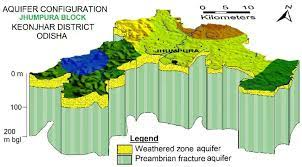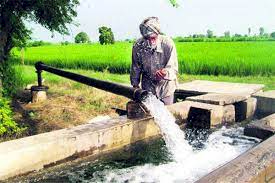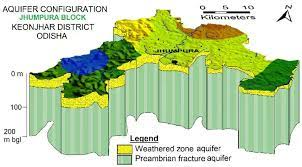National Aquifer Mapping and Management Programme (NAMMP)

Aquifers play a vital role in supplying freshwater for various human activities, including drinking water, agriculture, and industrial purposes. However, due to increasing water demands and unsustainable practices, many aquifers are facing depletion and degradation. Recognizing the need to address these issues, countries have initiated programs like the National Aquifer Mapping and Management Programme (NAMMP) to effectively manage and conserve groundwater resources.
Understanding Aquifers
Aquifers are underground geological formations composed of permeable rocks or sediments that can store and transmit water. They act as natural reservoirs, storing vast amounts of water that can be accessed through wells and boreholes. These underground water bodies are crucial for sustaining ecosystems and meeting human water needs.
Need for Aquifer Mapping and Management

With rapid population growth and industrialization, the demand for water has been increasing exponentially. Groundwater has become a critical source to meet this demand, leading to overexploitation and the depletion of aquifers. The consequences of unsustainable groundwater use include land subsidence, saltwater intrusion, and ecological imbalances. Therefore, there is an urgent need to assess, monitor, and manage aquifers effectively.
Overview of NAMMP
The National Aquifer Mapping and Management Programme (NAMMP) is a comprehensive initiative aimed at mapping and managing aquifers across the country. Its primary objectives are to identify potential aquifer zones, quantify groundwater availability, and assess its quality. NAMMP involves collaboration among government agencies, research institutions, and local communities to ensure the sustainable utilization of groundwater resources.
Implementation of NAMMP

NAMMP follows a systematic approach to gather data on aquifers and groundwater. It involves extensive field surveys, hydrogeological studies, and the use of remote sensing and geospatial techniques. Data collected through these methods is analyzed to generate detailed aquifer maps, which provide valuable insights into the distribution, characteristics, and behavior of groundwater resources. Additionally, water quality assessments help identify areas at risk of contamination and facilitate appropriate remedial measures. Read also- Jal Jan Abhiyan
Benefits of NAMMP
The implementation of NAMMP brings several benefits to the sustainable management of water resources. Firstly, it enables policymakers and water managers to make informed decisions based on reliable data and scientific assessments. This helps prevent overexploitation and ensures the long-term availability of water for future generations.
Secondly, NAMMP facilitates integrated water resource planning by identifying potential recharge areas, vulnerable zones, and areas suitable for artificial recharge projects. It aids in optimizing the allocation of water resources for different sectors, promoting efficient water use and minimizing conflicts.
Challenges and Limitations
Implementing NAMMP comes with certain challenges and limitations. One of the primary hurdles is availability and accuracy of data. Comprehensive aquifer mapping requires extensive data collection, which may be incomplete or outdated in some regions. Moreover, financial constraints can limit the scope and pace of the program, hindering its effectiveness in certain areas. Overcoming these challenges requires increased investment in data collection, technological advancements, and capacity building.
Case Studies
Several regions have successfully implemented NAMMP, leading to positive outcomes in water management. For example, in a specific state, NAMMP helped identify potential recharge areas and facilitated the construction of recharge structures. This led to the replenishment of groundwater levels and improved availability of water for irrigation, resulting in increased agricultural productivity and reduced dependence on unsustainable water sources.
Future Scope and Expansion
The success of NAMMP has paved the way for its integration with other water management programs. By incorporating data from rainfall patterns, surface water resources, and climate change projections, NAMMP can enhance its effectiveness in predicting aquifer behavior and identifying future challenges. Additionally, advancements in technology, such as remote sensing and machine learning algorithms, offer opportunities for more accurate and efficient aquifer mapping.
Conclusion
The National Aquifer Mapping and Management Programme (NAMMP) plays a crucial role in ensuring the sustainable management of groundwater resources. By systematically mapping aquifers and assessing their characteristics, NAMMP provides valuable insights for informed decision-making, efficient water allocation, and the prevention of overexploitation. Despite challenges, the program’s implementation has shown positive outcomes in various regions, contributing to the conservation and availability of freshwater resources.
FAQs
What is NAMMP?
NAMMP stands for National Aquifer Mapping and Management Programme. It is an initiative aimed at mapping and managing aquifers across the country to ensure sustainable utilization of groundwater resources.
Why is aquifer mapping important?
Aquifer mapping is essential to understand the distribution, availability, and quality of groundwater resources. It helps in informed decision-making, sustainable water management, and the prevention of overexploitation.
Who is involved in NAMMP?
NAMMP involves collaboration among government agencies, research institutions, and local communities to gather data, analyze aquifer behavior, and implement effective management strategies.
What are the benefits of NAMMP?
NAMMP brings benefits such as informed decision-making, optimized water allocation, improved water resource planning, and increased agricultural productivity through sustainable groundwater use.
What are the challenges in implementing NAMMP?
Challenges include data availability and accuracy, financial constraints, and the need for technological advancements. Overcoming these challenges requires increased investment and capacity building.

1 thought on “National Aquifer Mapping and Management Programme (NAMMP)”